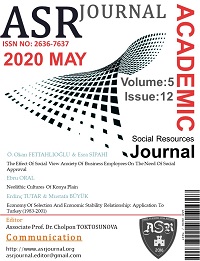Author :
Abstract
Bu çalışmanın genel amacı; işletmelerde çalışanların sosyal görünüş kaygısının, sosyal onay ihtiyacı üzerinde etkisinin olup olmadığını tespit etmeye yöneliktir. Çalışmanın genel amacına yönelik alt amaçlarında ise; katılımcıların sosyal görünüş kaygısı ve sosyal onay ihtiyacı ile alt boyutlarının düzeylerini; değişkenler arasında etkileşim olup olmadığını ortaya koymak hedeflenmiştir. Yöntem: Bu çalışmada iki değişken arasında etki olup olmadığının tespitine yönelik olduğundan, kurgulanan model de etkileşimsel model biçiminde desenlenmiştir. Bu kapsamda, sosyal onay ihtiyacı ve alt boyutları ile sosyal görünüş kaygısı arasındaki ilişki ve etkileşim ayrı ayrı ele alınmıştır. Araştırmanın örneklem grubu, Adana ve Mersin illerinde imalat sektöründe üst ve alt pozisyonda çalışan toplam 424 bireylerden oluşturmaktadır. Araştırma kapsamında veri toplayabilmek adına, Karaşar ve Öğülmüş (2016) tarafından geliştirilmiş olan üç boyutlu ve 25 adet soru önermesinden oluşan “Sosyal Onay İhtiyacı Ölçeği” ile birlikte Hart ve arkadaşları (2008) tarafından geliştirilen, Doğan (2010) tarafından Türkçeye uyarlanmış olan tek boyutlu ve 16 soru önermesinden oluşan “Sosyal Görünüş Kaygısı Ölçeği” kullanılmıştır. Söz konusu ölçeklerle toplanan verilerin istatistiki çözümleri için veri analizi programı olan SPSS 21.0 kullanılmıştır. Bulgular: Elde edilen bulgulara göre sosyal onay ihtiyacı ve alt boyutları ile sosyal görünüş kaygısı arasında (r=,383; ile r=,501 aralığında p<0,00) düşük ve orta düzeyde pozitif yönlü anlamlı bir ilişki olduğunu tespit edilmiştir. Ayrıca sosyal görünüş kaygısına yönelik algılamalarının, sosyal onay ihtiyacına yönelik algılamalarını [(β=,461), (p<0.05)] (R2:,212; p:,000) pozitif yönde etkilediği sonucuna ulaşılmıştır. Tartışma: Çalışanların sosyal görünüş kaygısının, sosyal onay ihtiyacı üzerinde etkisinin olup olmadığının tespit edilmeye çalışıldığı bu çalışmada, sosyal görünüş kaygısı taşıyan çalışanların, sosyal onay ihtiyacı hissetme yönündeki algılamaları da aynı doğrultuda etkilenebileceği beklenen bir durum olarak karşımıza çıkmıştır.
Keywords
Abstract
The general purpose of this study; to determine whether the social appearance anxiety of the personnel working in the enterprises has an impact on the need for social approval. In the sub-objectives for the general purpose of the study; the levels of sub-dimensions of the participants' social appearance anxiety, need for social approval and sub-dimensions; It is aimed to reveal whether there is an interaction between the mentioned variables. Method: Since this study is for determining whether there is an effect between the two variables, the model was designed in the form of an interactive model. In this context, the relationship and interaction between social approval needs and sub-dimensions and social appearance anxiety are discussed separately. The sample group of the research consists of 424 personnel working in the upper and lower positions in the manufacturing sector in Adana and Mersin provinces. In order to collect data within the scope of the research, the social approval need scale developed by Karaşar and Öğmiş (2016) and consisting of three questions and 25 questions were used. In addition, a one-dimensional social appearance anxiety scale developed by Hart et al. (2008) and adapted to Turkish by Doğan (2010) and consisting of 16 questions was used. SPSS 21.0, a data analysis program, was used for the statistical solutions of the data collected with these scales. Results: As a result of the findings obtained, it was concluded that there was a low and moderately positive significant relationship between the need for social approval and its sub-dimensions and social appearance anxiety (r =, 383; and r =, 501 p <0.00). In addition, it was determined that perceptions about social appearance anxiety positively affect their perceptions about social approval need [(β =,461), (p <0.05)] (R2:, 212; p:,000). Discussion: In this research, in which employees' social appearance anxiety has an effect on the need for social approval, this study has emerged as an expected situation in which employees with social appearance anxiety can be affected in the same direction.
Keywords
- Fettahlıoğlu, Ö.O. & Sipahi, E. (2020). “İşletme Çalışanlarının Sosyal Görünüş Kaygısının, Sosyal Onay
- pp:21-30 ÖZET Bu çalışmanın genel amacı; işletmelerde çalışanların sosyal görünüş kaygısının, sosyal onay ihtiyacı üzerinde etkisinin olup olmadığını tespit etmeye yöneliktir. Çalışmanın genel amacına yönelik alt amaçlarında ise; katılımcıların sosyal görünüş kaygısı ve sosyal onay ihtiyacı ile alt boyutlarının düzeylerini; değişkenler arasında etkileşim olup olmadığını ortaya koymak hedeflenmiştir. Yöntem: Bu çalışmada iki değişken arasında etki olup olmadığının tespitine yönelik olduğundan, kurgulanan model de etkileşimsel model biçiminde desenlenmiştir. Bu kapsamda, sosyal onay ihtiyacı ve alt boyutları ile sosyal görünüş kaygısı arasındaki ilişki ve etkileşim ayrı ayrı ele alınmıştır. Araştırmanın örneklem grubu, Adana ve Mersin illerinde imalat sektöründe üst ve alt pozisyonda çalışan toplam 424 bireylerden oluşturmaktadır. Araştırma kapsamında veri toplayabilmek adına, Karaşar ve Öğülmüş (2016) tarafından geliştirilmiş olan üç boyutlu ve 25 adet soru önermesinden oluşan “Sosyal Onay İhtiyacı Ölçeği” ile birlikte Hart ve arkadaşları (2008) tarafından geliştirilen, Doğan (2010) tarafından Türkçeye uyarlanmış olan tek boyutlu ve 16 soru önermesinden oluşan “Sosyal Görünüş Kaygısı Ölçeği” kullanılmıştır. Söz konusu ölçeklerle toplanan verilerin istatistiki çözümleri için veri analizi programı olan SPSS 21.0 kullanılmıştır. Bulgular: Elde edilen bulgulara göre sosyal onay ihtiyacı ve alt boyutları ile sosyal görünüş kaygısı arasında (r=,383; ile r=,501 aralığında p<0,00) düşük ve orta düzeyde pozitif yönlü anlamlı bir ilişki olduğunu tespit edilmiştir. Ayrıca sosyal görünüş kaygısına yönelik algılamalarının, sosyal onay ihtiyacına yönelik algılamalarını [(β=,461), (p<0.05)] (R2:,212; p:,000) pozitif yönde etkilediği sonucuna ulaşılmıştır. Tartışma: Çalışanların sosyal görünüş kaygısının, sosyal onay ihtiyacı üzerinde etkisinin olup olmadığının tespit edilmeye çalışıldığı bu çalışmada, sosyal görünüş kaygısı taşıyan çalışanların, sosyal onay ihtiyacı hissetme yönündeki algılamaları da aynı doğrultuda etkilenebileceği beklenen bir durum olarak karşımıza çıkmıştır. Anahtar Kelimeler: Yönetici ve Çalışanlar, Sosyal Onay İhtiyacı, Sosyal Görünüş Kaygısı, İmalat İşletmeleri ABSTRACT





